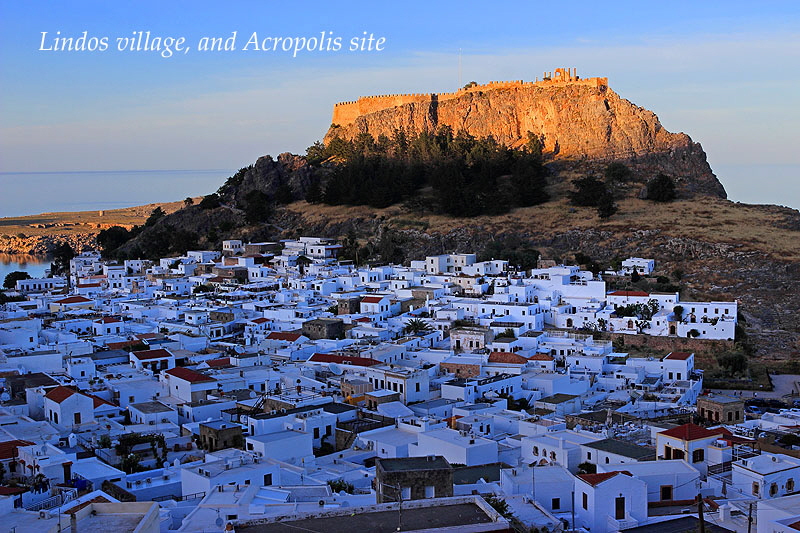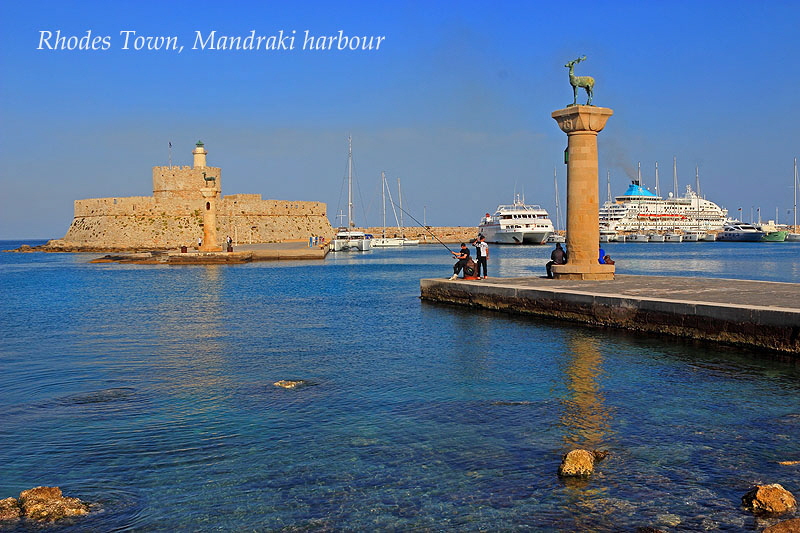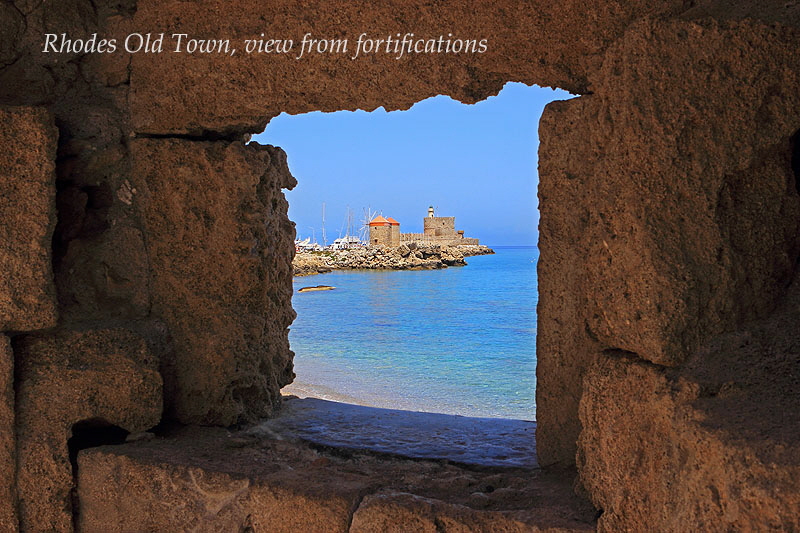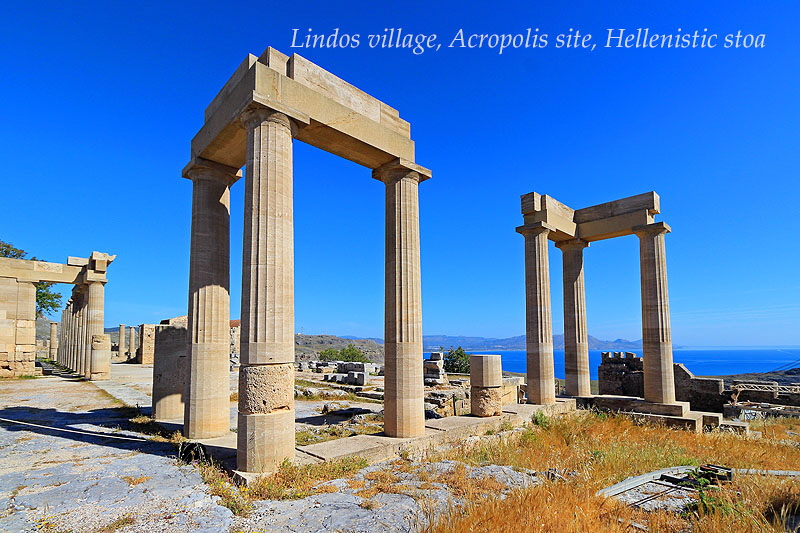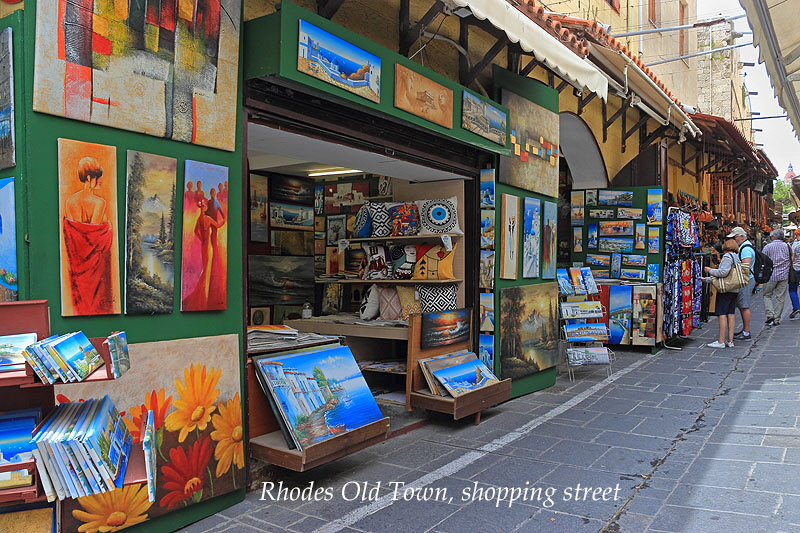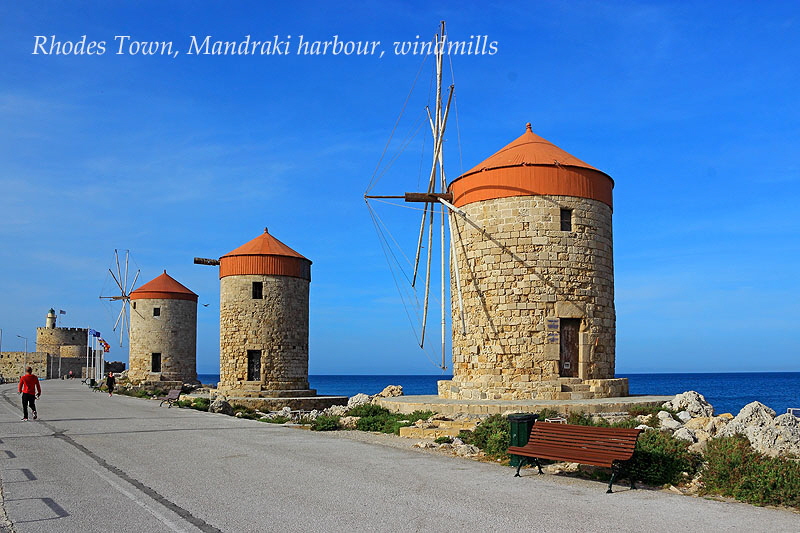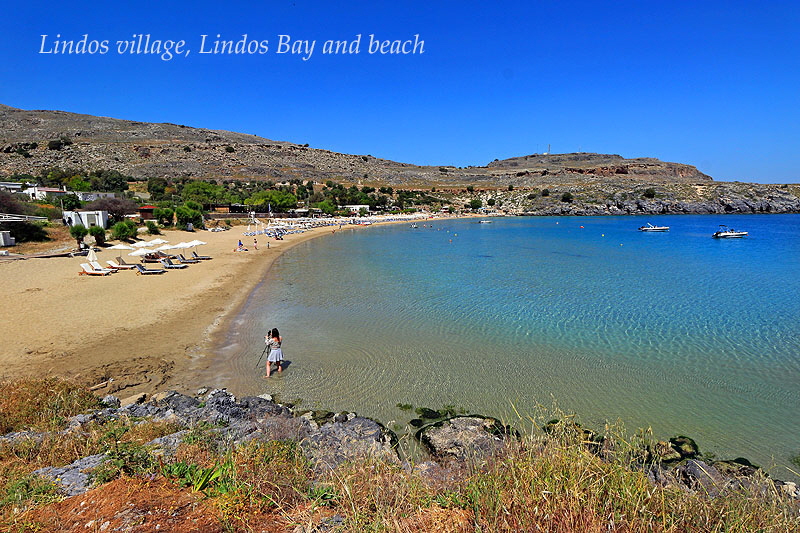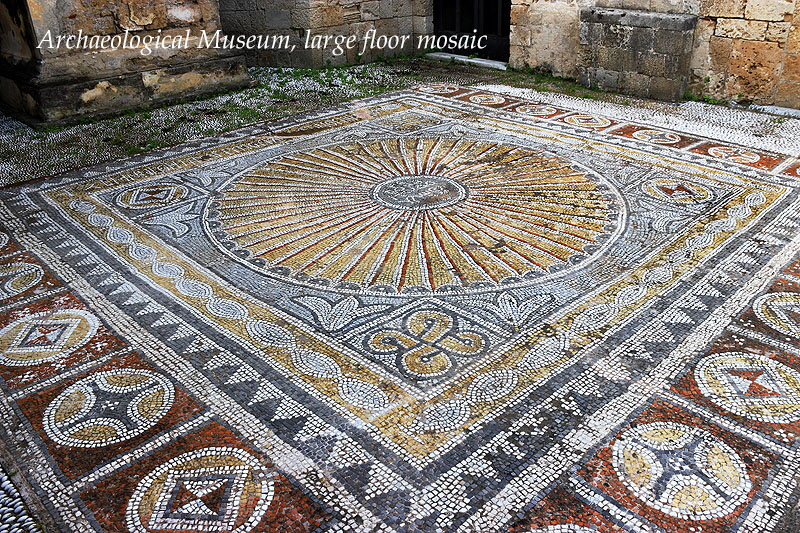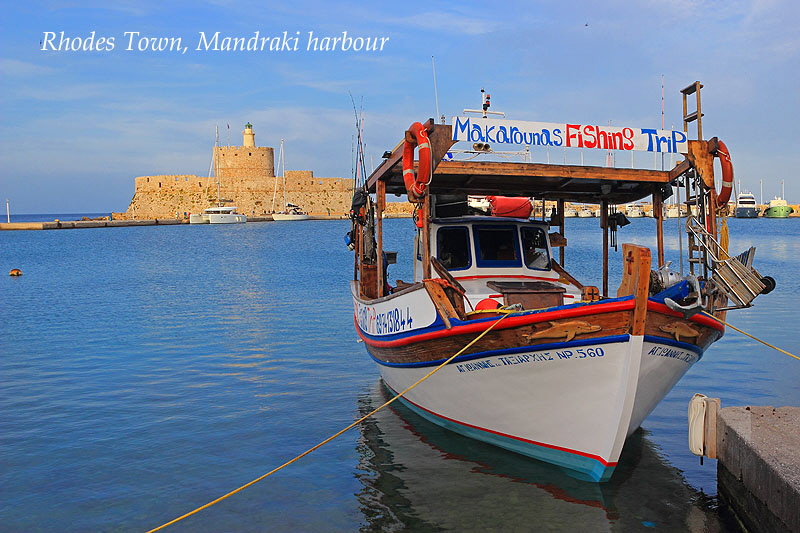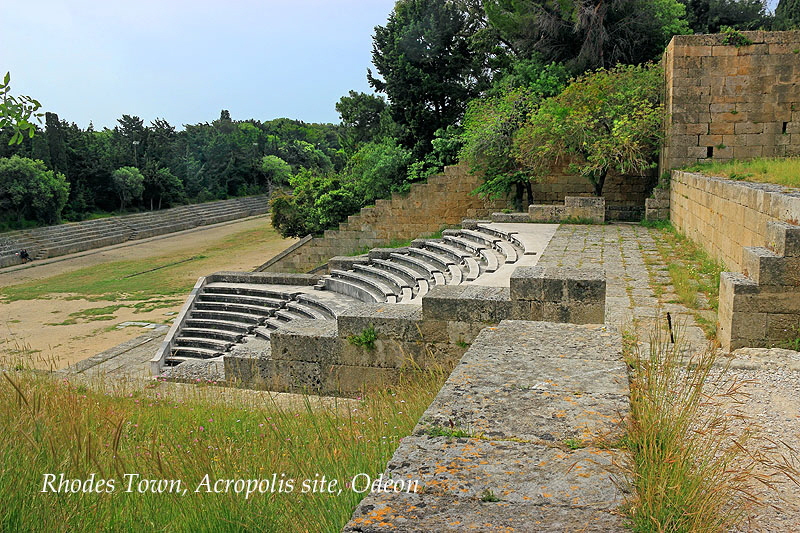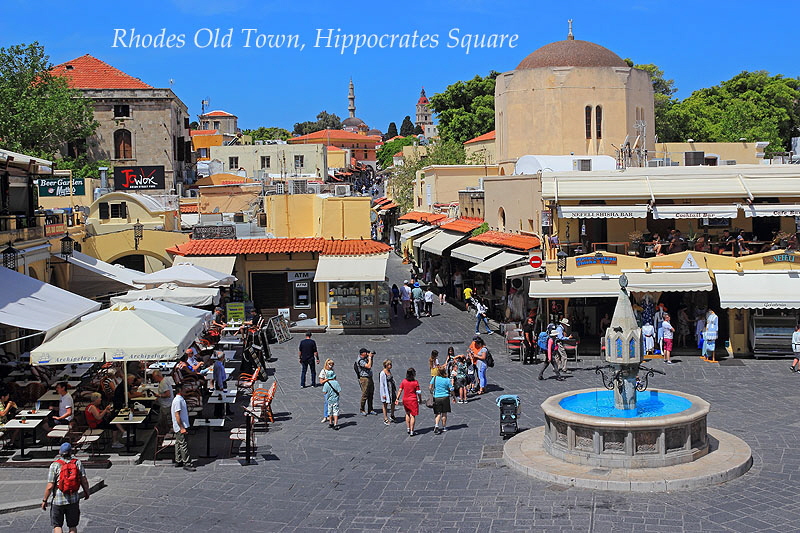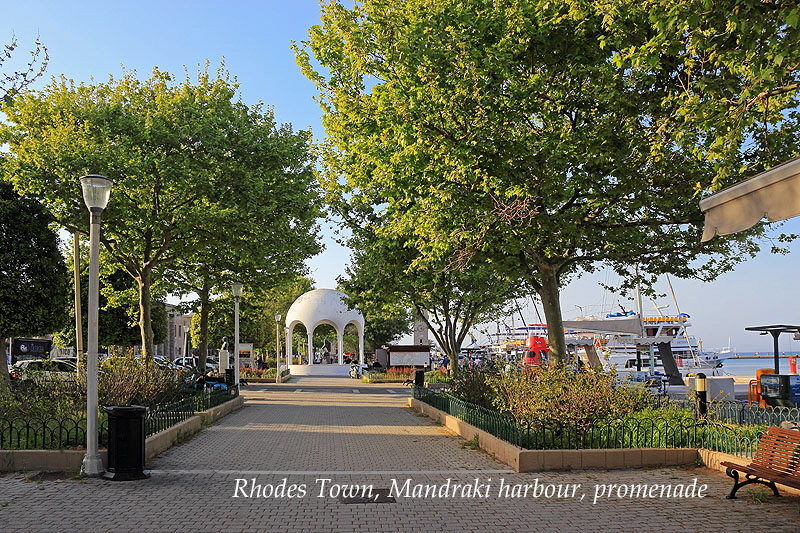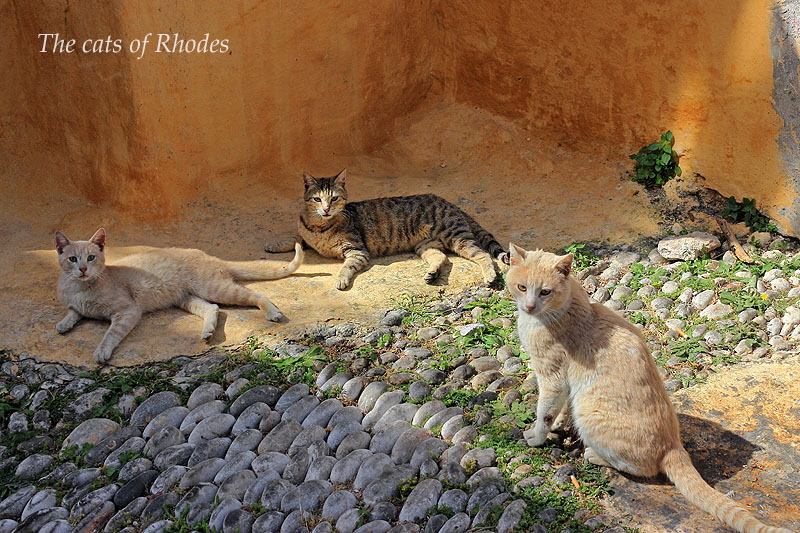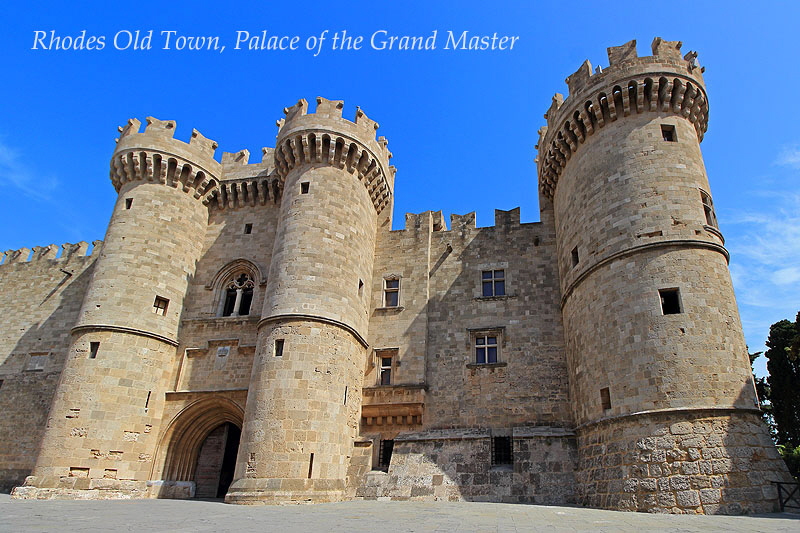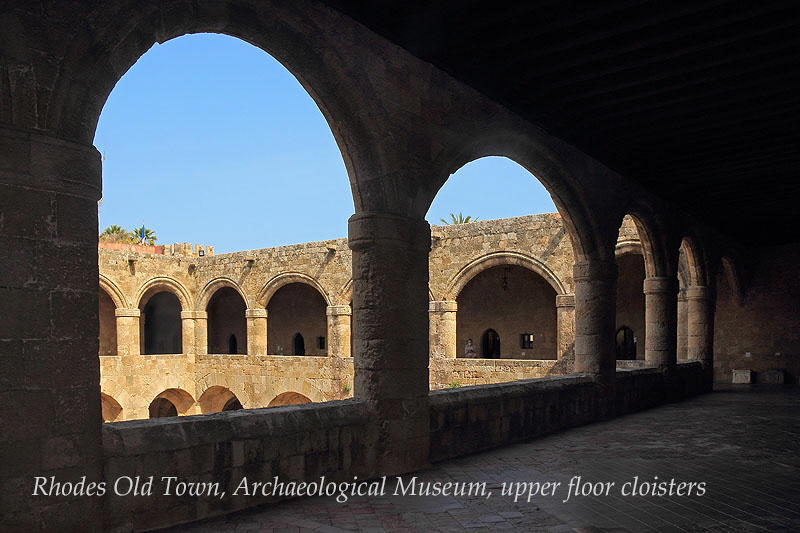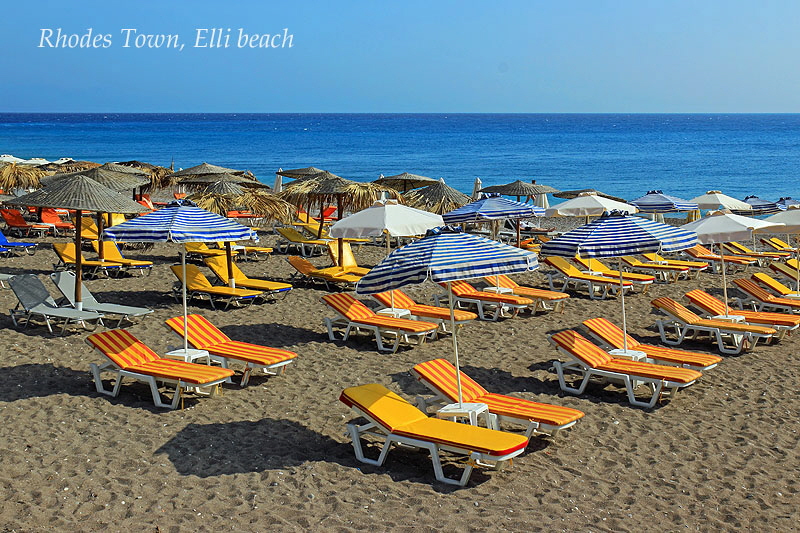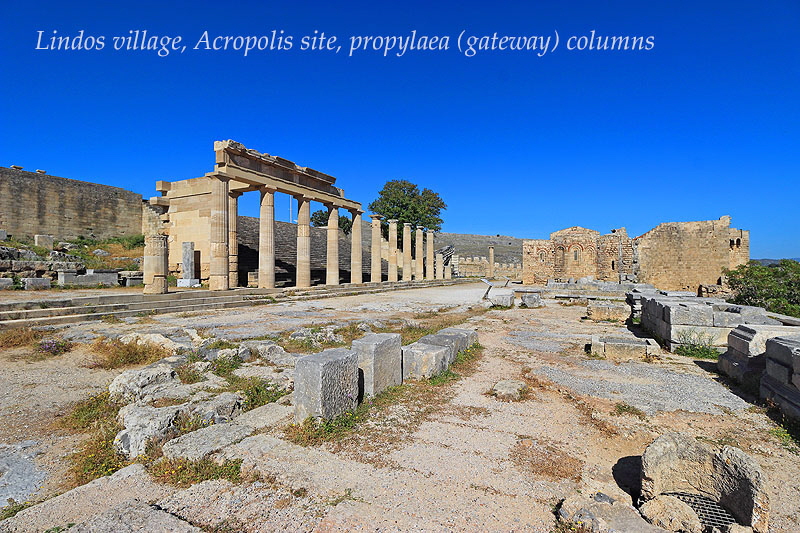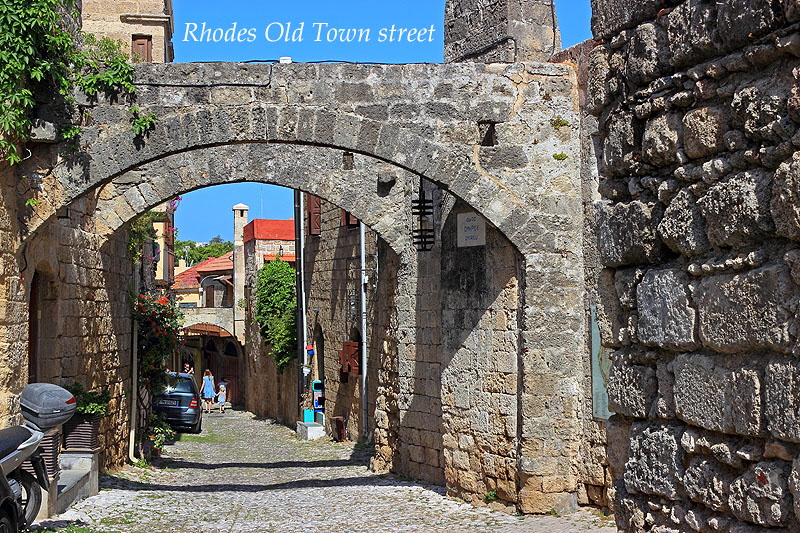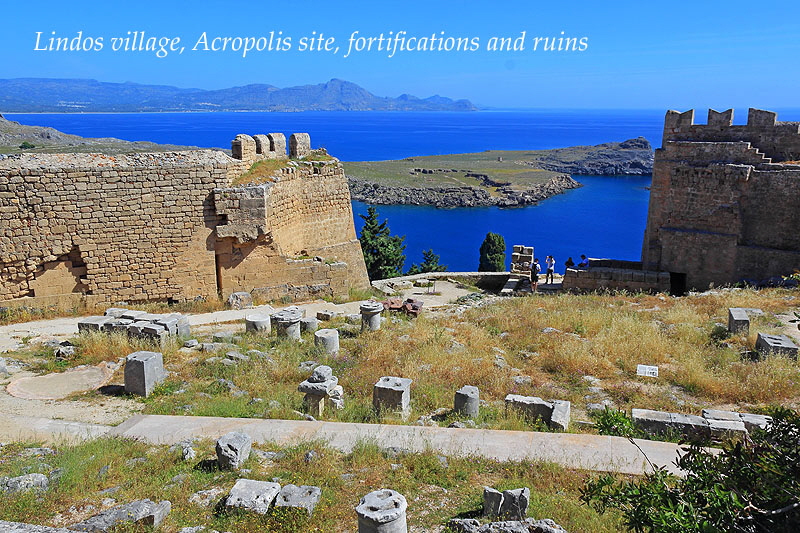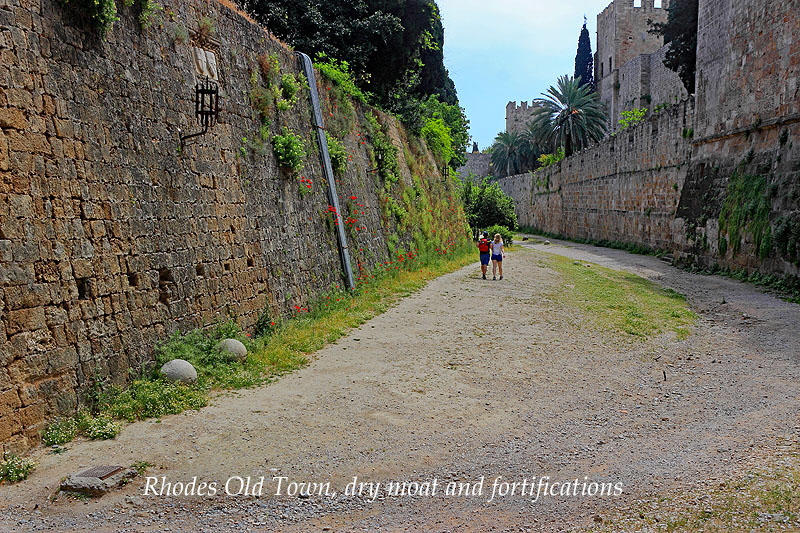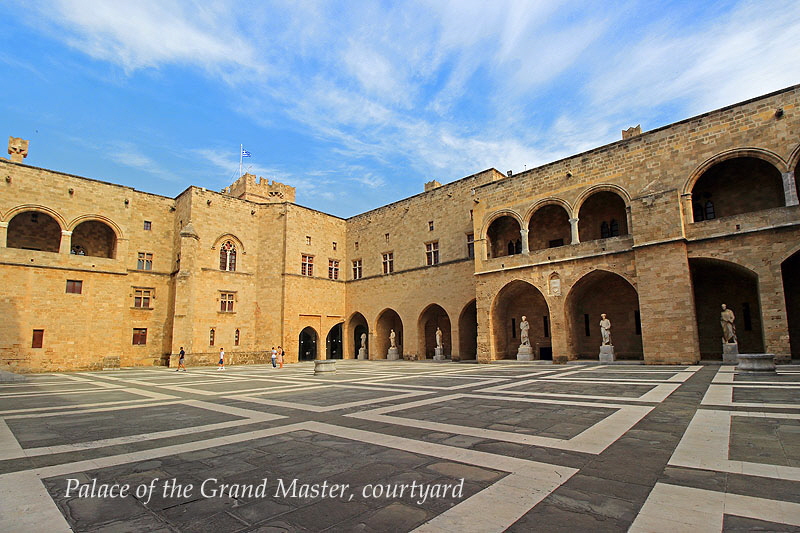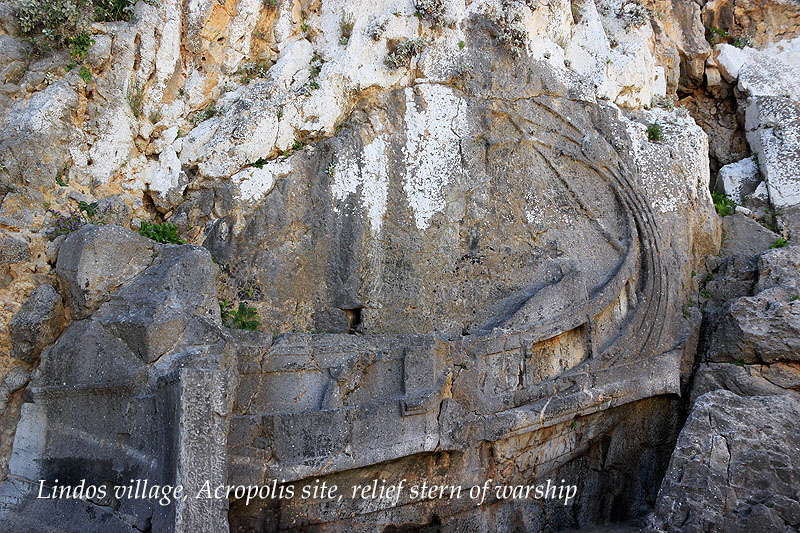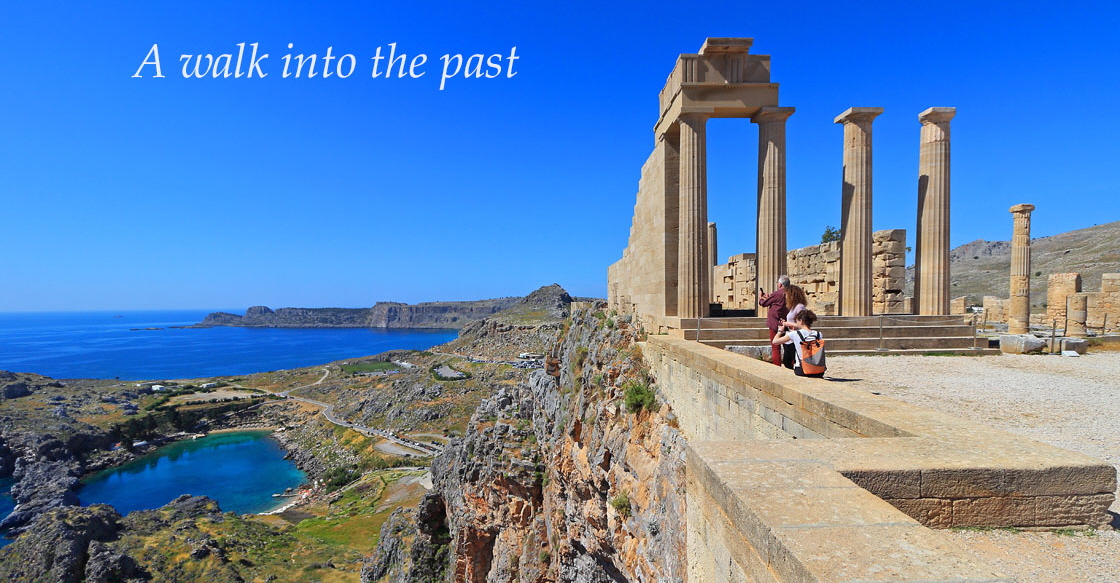
Steeped in history, soaked in sunshine,
Rhodes is one of the most beautiful Greek Islands
that beckons the discerning traveller.
Lindos Acropolis
It was a lovely blue-sky day in April when I arrived at Rhodes airport, and my taxi driver was already there to greet me and drive
50 km southeast to the village of Lindos.
While most visors to Rhodes tend to visit this village on a day trip, by land or sea, having read so much about the place, I had decided to spend a few days here.
Approaching the town from the hillside main road, the view looking down on the glistening whitewashed houses instantly captivated me. As no cars can drive through the narrow streets of the village, the driver stopped by the main roadside and pointed towards the Lindos Harmony Suites hotel just two minutes down a steep, uneven path.
Putting down my luggage aside, I couldn’t help but pause for a few moments to take in the panoramic sight of the entire village below me.
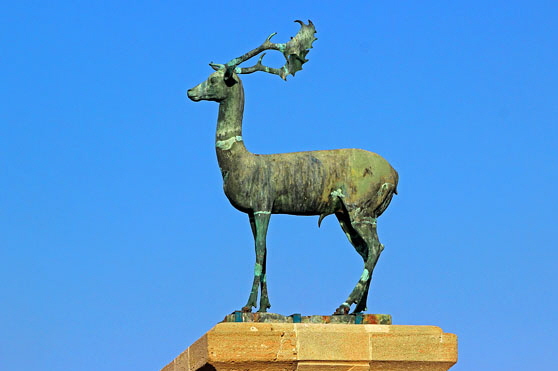
The Stag, heraldic symbol of Rhodes
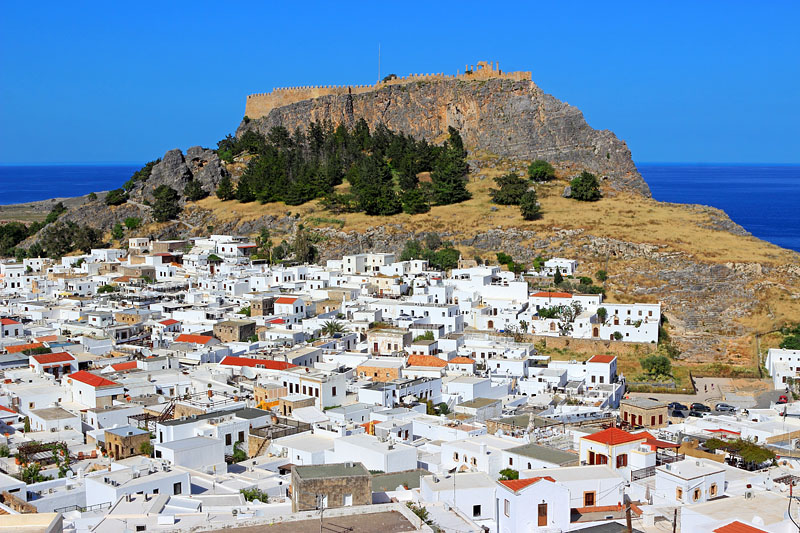
Lindos village and Acropolis site
Checking in, I received a warm welcome and was shown to my suite, just one of nine in the hotel. Beautifully furnished, and best of all, from the window, was an uninterrupted view of the famous rocky hilltop Acropolis.
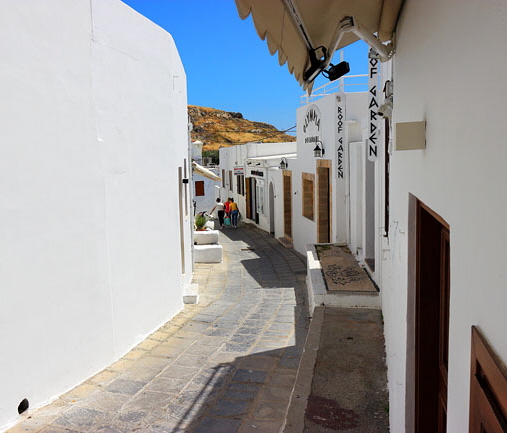
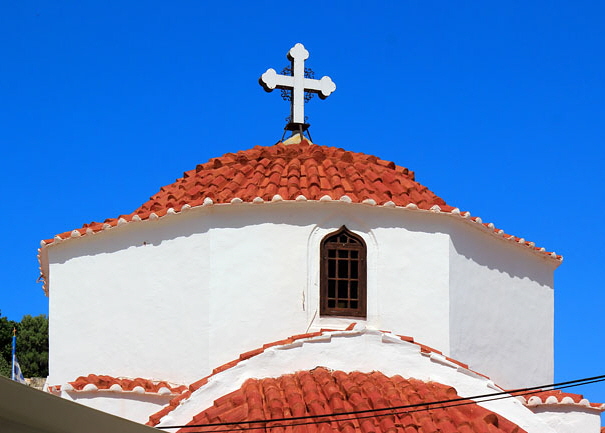
While the ancient Acropolis is the main attraction that draws visitors, I wished to spend my time in an unhurried fashion and absorb the atmosphere. More than enough has been written about the archaeological finds so won’t bore you with the same information which you can easily find in numerous guidebooks and online.
From my hotel, it was a steep five minute walk to the main hub of the village. The path downhill was narrow and rugged (good walking shoes are essential) passing four or five cats grouped lazing in a shady spot. The main streets in the town are crammed with small boutiques and restaurants. Despite being off-season, there was still a fair crowd of tourists meandering the narrow streets.
I headed towards the whitewashed 14th century Church of Panagia. In the tiny courtyard, reaching for the sky is the four-tier stone bell tower. It was Easter weekend, and the church service was in session, so not wishing to disturb, I only managed a quick glimpse of the hanging chandeliers inside.
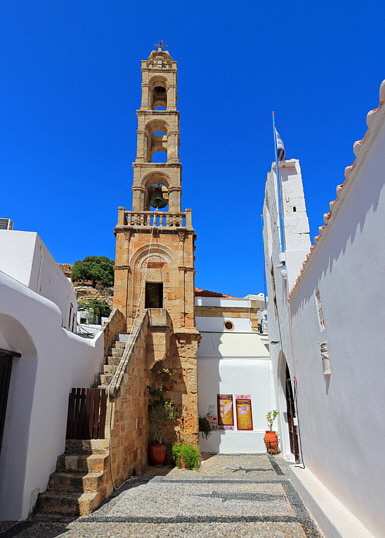
Panagia Church bell tower
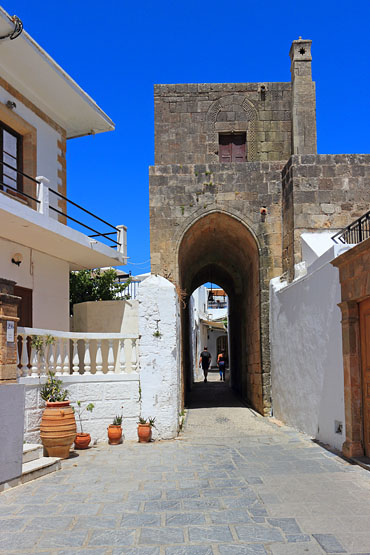
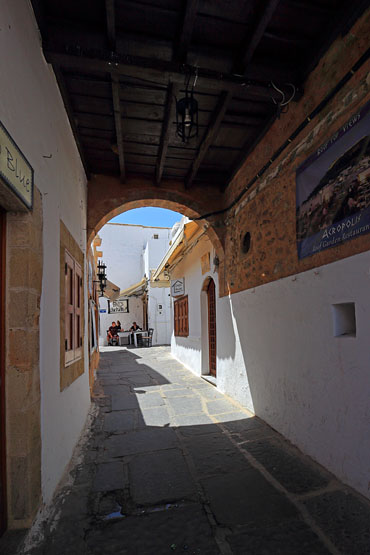
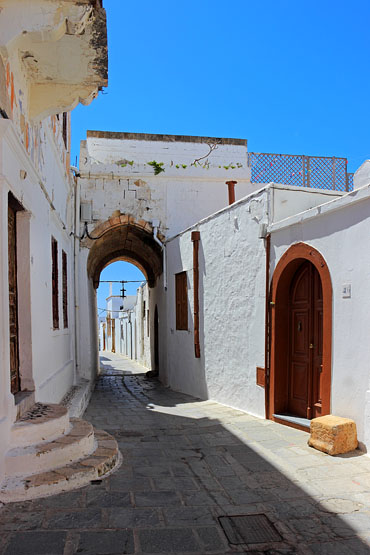
One of the most enjoyable things is just getting lost in the compact maze of narrow streets. And in almost every direction you looked, there was something picturesque to photograph. Passing through archways, I paused to observe small houses with wooden doorways, and fronts decorated with potted plants. Rhodes is famous for its hohlaki flooring - a work of art, which are mosaic patterns created using smooth black and white pebbles. In Lindos, there are so many, at home fronts, little steps leading to houses, and even along stepped paths and streets.
In a couple of main roads in the village is an abundance of souvenir shops, where gently persuasive vendors, invite you to show off their local pottery, crafts, oils and spices.
By lunch time, the restauranters are out by their entrances vying for your custom. And the luckiest ones are those who have rooftop restaurants and bars. I dined at several of them, both at lunch and in the evening. All boast of the ‘view’ referring mainly to the Acropolis, as well as the coast and town. And on a balmy afternoon, tucking into calamari with salad lunch, washed down with an ice-cold beer, and a view of the Acropolis ahead of me, it couldn’t be any more idyllic. Apart from the views, the food is not to be overlooked. The service of course was always friendly.
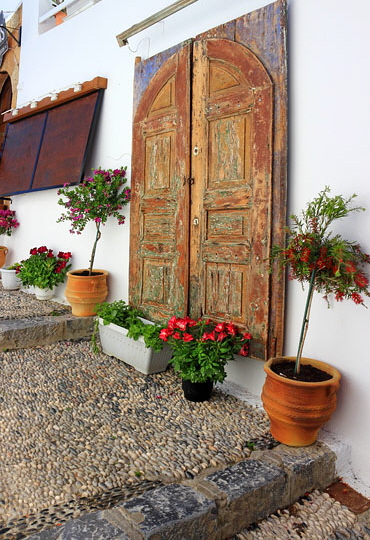
Hohlaki mosaic paving
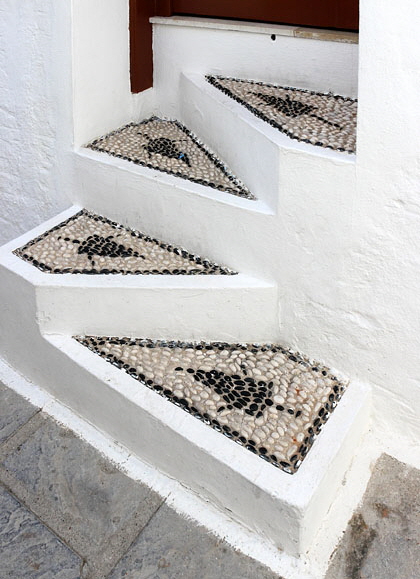
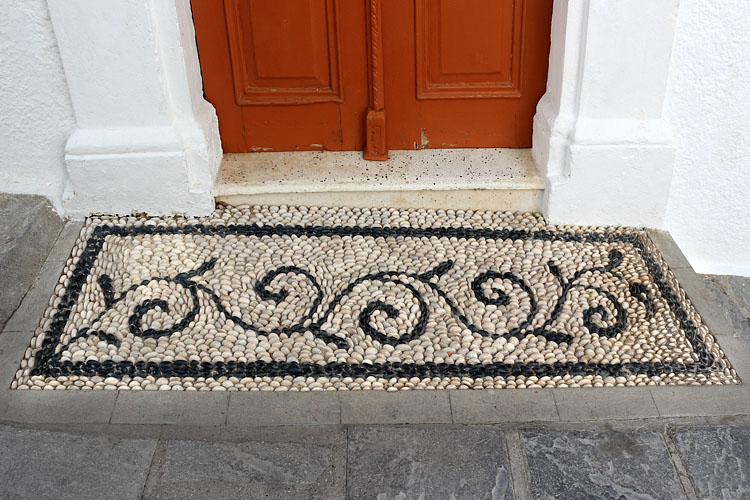
One morning, a stroll just 10 minutes south of the village, took me to the ruins of the Ancient Theatre. Dating back to the 3rd century BC, it once hosted around 1800 spectators witnessing mainly sporting events. Lying at the west slopes and base of the Acropolis, it is an often overlooked site, understandably, as there is not much to see. Nevertheless, some of the granite cut seating of the amphitheatre are still visible, despite being overrun by grasses and wildflowers.
Remains of the Ancient Theatre
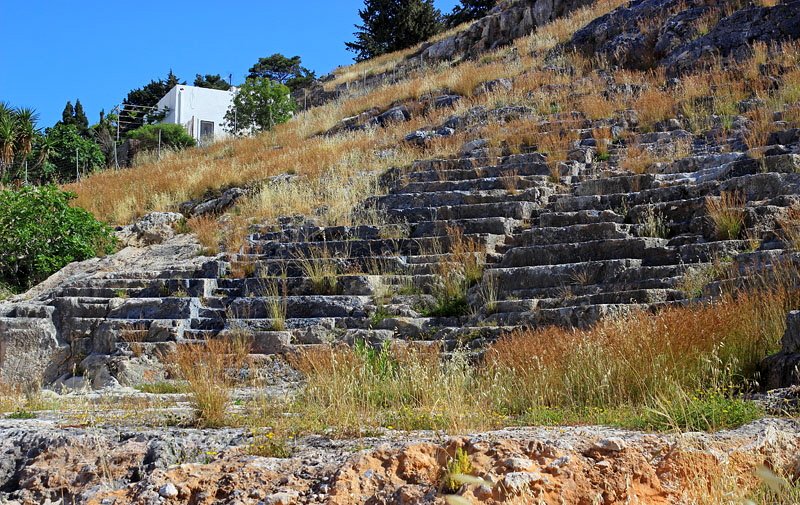
Walking further south, the picturesque view of St Paul’s Bay awaits you. It was another gorgeous Spring morning, and a downhill road toward the sea was a visual feast. The semi-circular bay with clear turquoise blue water and the rocky hill with the Acropolis as the backdrop has to be one of the most stunning Greek island beauty spots.
Strolling further down is a small chapel by the coast, and along the beach are sunbeds with sunshades available for hire for those who wished to spend the day. The water is shallow and calm and there were no more than a dozen holidaymakers already testing the still ice-cold waters. So quiet and peaceful, the sound of silence is only broken by a few donkeys braying nearby. Approaching midday, the warm temperature edged me towards the beachside cafe for a cool drink and snack.
St Paul’s Bay
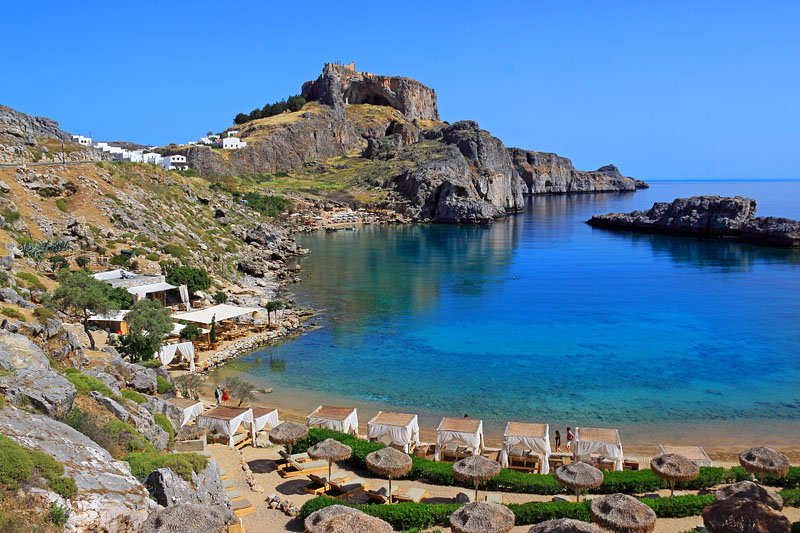
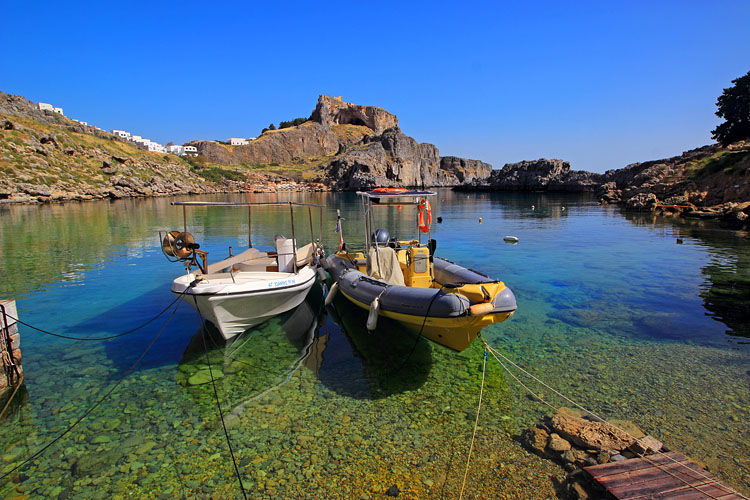

If swimming and sunbathing are on your daily agenda, then one couldn’t do better than Lindos Beach. Bigger than St Paul’s Bay, and more equipped with restaurants and watersports, it’s about a 20 minute walk along a winding road from the village square. While the walk downhill is scenic and easy, it’s quite a strenuous trek back uphill. I was told that during the summer months however, a shuttle ride operates to the beach. The soft sandy beach is perfect for families and I could imagine the place overrun by tourists at the height of the season. Discovering a nature trail nearby, it took me partially uphill for panoramic views of the bay and beach.
Lindos Bay and beach
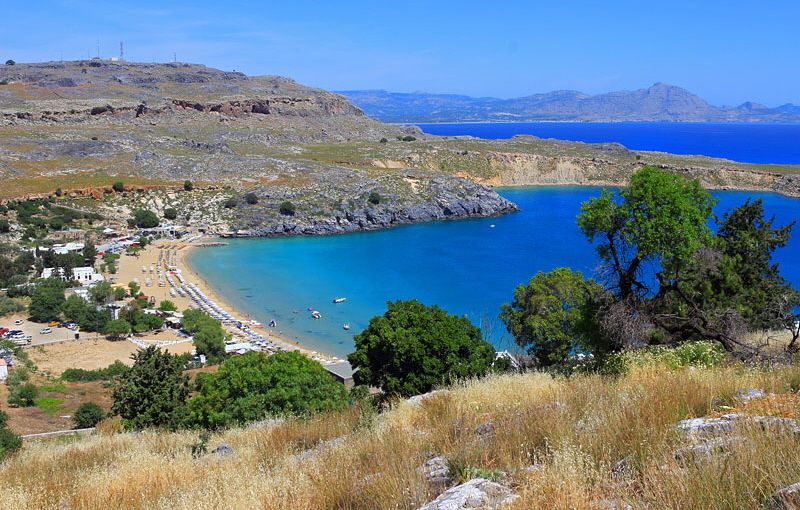
The ancient citadel, with awesome views
The pièce de résistance of my stay was of course a visit to the Acropolis. As most visitors from other parts of Rhodes arrive by late morning, to avoid the crowds, I was up early, and by 8 am on the way to the site. From my hotel, it says 20-30 minute walk, and as the route takes you through the village you’d notice little signs pointing towards the path leading to the site uphill.
It was a lovely easy walk, and not needing to rush, I could stop and admire the views as I moved along. For visitors’ pleasure, donkey rides to the top are available, but it did not appeal to me. They may be traditionally used for work, but it is no excuse for making these poor animals carry heavy tourists. At the entrance, there was hardly anyone, and I had to look for the ticket officer to purchase my entry (12 Euros)
Village view from the fortifications
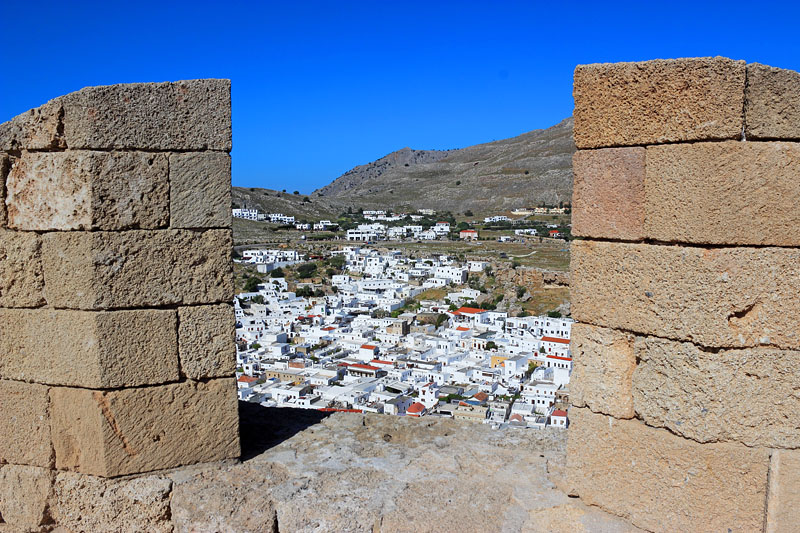
It is a good idea to read a little about the place to appreciate the wonders of this ancient site that dates back to 300 BC. With many periods of occupation, colonisation and construction, it can be too much to take in at one time. For me, the feeling of being here was thrilling enough. From the entrance stairway, where there is a huge rock relief carving of a warship dating back to 180 BC, are the steps leading through the fortified walls.
Temple of Athena
Gateway columns
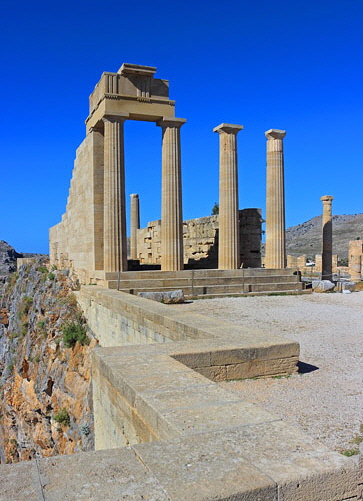
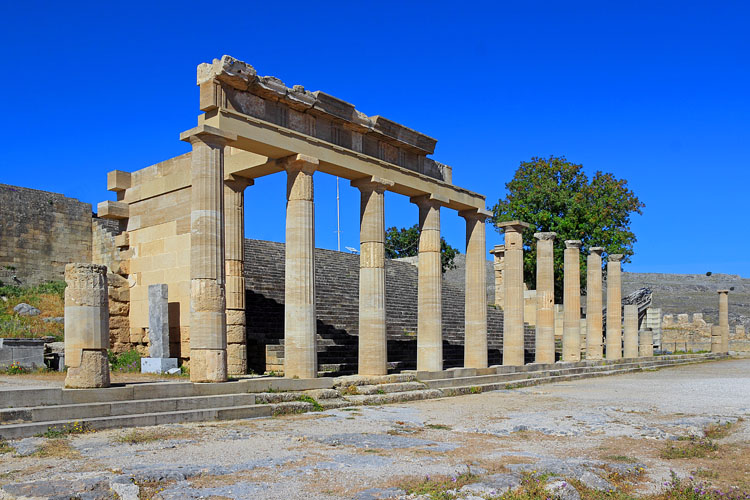

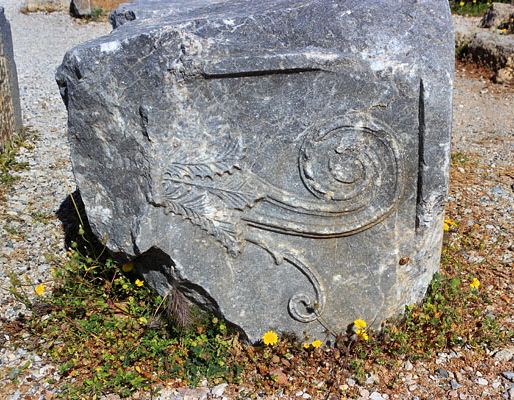
Ruins of the church of St John
Relief carvings
The ancient Temple of Athena, ruins of the Byzantine church of St John, and the columns of the propylaea (gateway) are a few of the wonderful sights you’ll encounter. Although some parts (like sections of the Athena columns have been restored, most remain untouched. Walking among overgrown grasses and wildflowers, notice the relief carvings on some of the fallen columns and slabs of a Roman temple.
Fortifications and panoramic views
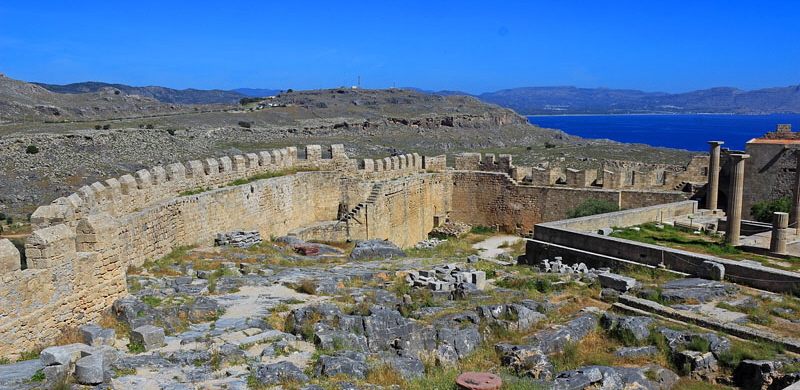
Then there are the incredible views. On the west side, you get to see the entire village of Lindos below, on the south, the dramatic coast of St Paul’s Bay, and in the north, Lindos Beach in the distance. This was not a site where I could walk around in 20 minutes and go back as many day-trippers do. The sun was warm, and the gentle breeze cool, and I was in my element exploring the site at leisure, or sitting on a stone slab to marvel at the surroundings.
View toward St Paul’s Bay

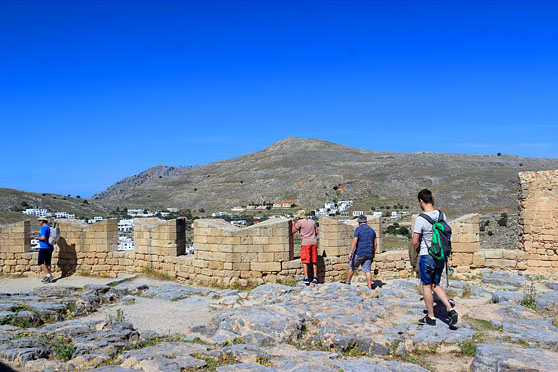
An hour later, groups of tourists began to arrive. It was my moment to head back to the village. And after four days of sightseeing and just chilling out, I was ready to head north to Rhodes Town.
An entire city that was once a stronghold
Few places can claim that their entire old town is a historic site. The medieval part of Rhodes Town can justifiably claim so. I am no history buff but do love being in the presence of the past. While most holidaymakers reside in seaside resorts and visit Rhodes Town on a day trip, I spent many more days enjoying the delights of this fascinating town and its rich history.
RhodesTown, Old Town, St Paul’s Gate
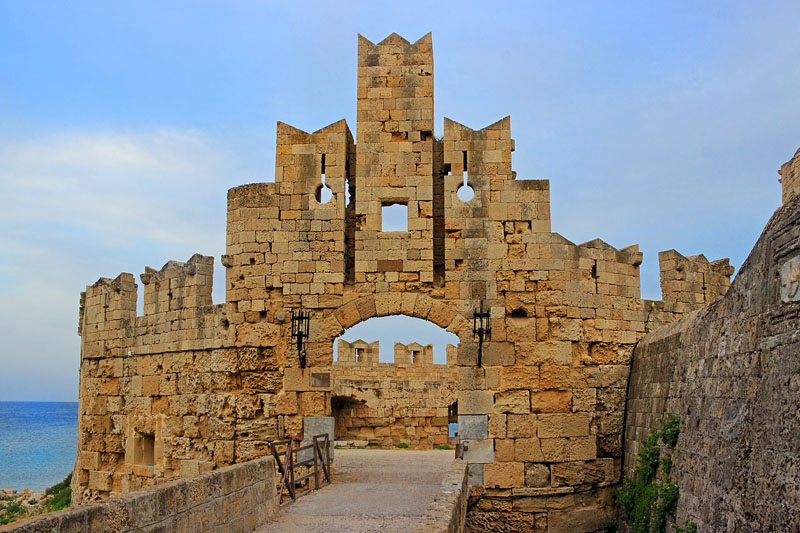
Divided as old and new towns, the Old Town is distinctly separated by fortified walls that surround it. Declared as a World Heritage Site by UNESCO, its turbulent history spans periods of many invasions and occupations. From the Greeks, the Knights of
St John, the Ottoman Turks, Italians, and finally Greeks, it has left indelible marks everywhere in the town. And its imposing evidence is plain to see in the various architectural styles and buildings.
This is a very easy, walkable town and several well preserved magnificent gateways lead into the Old Town. Most of the historic and archaeological sites are also within the walls. Located at the highest point is the Palace of the Grand Master, the huge stronghold, built by the Knights of St John who ruled Rhodes for more than two centuries. It’s a treasure-trove of art, architecture,
and some wonderful floor mosaics. The building itself is impressive, with a large courtyard and cloisters.
Palace of the Grand Master, entrance
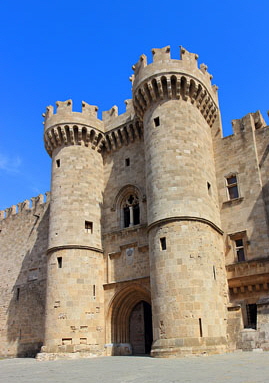
Palace courtyard
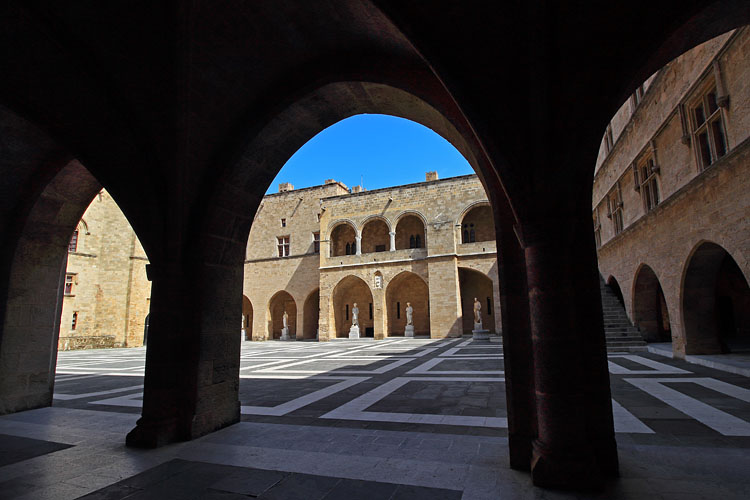
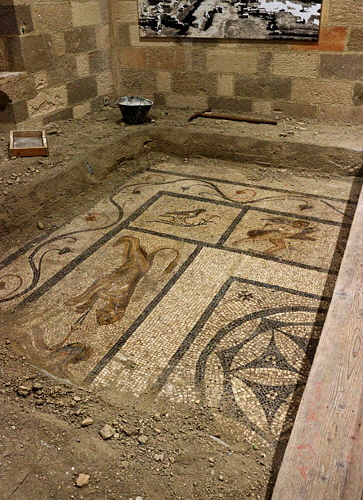
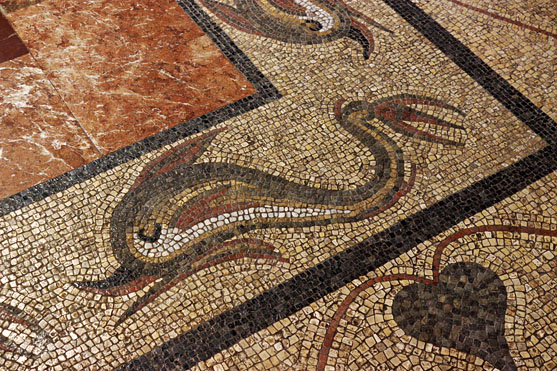
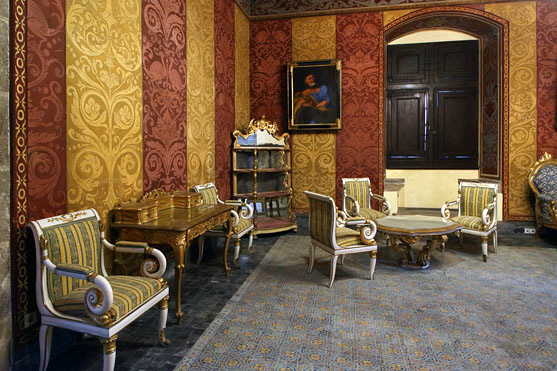
Equally interesting is the Archaeological Museum, housed in the vast 15th century Knight’s Hospital building. From the sunny courtyard, steps lead to two levels of galleries. The galleries themselves house a splendid collection of artefacts and treasures from both Rhodes and nearby islands. I especially enjoyed the lovely gardens, and open-air exhibits, making it a peaceful place to spend a couple of hours.

Archaeological Museum
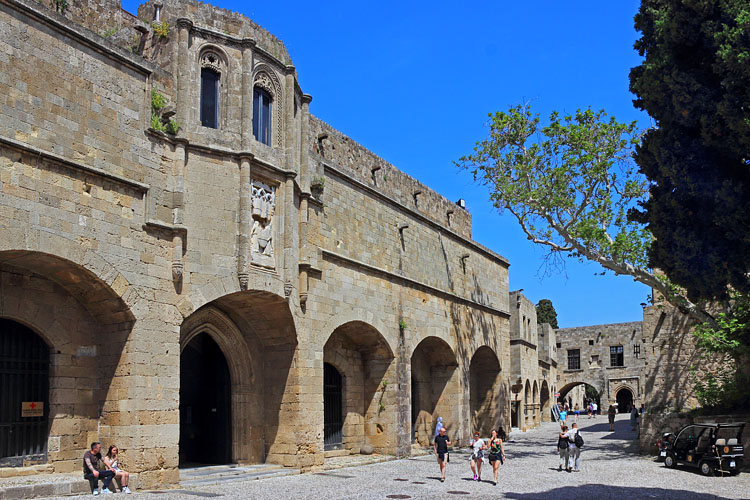
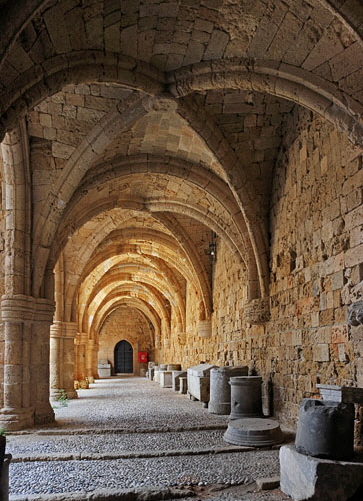
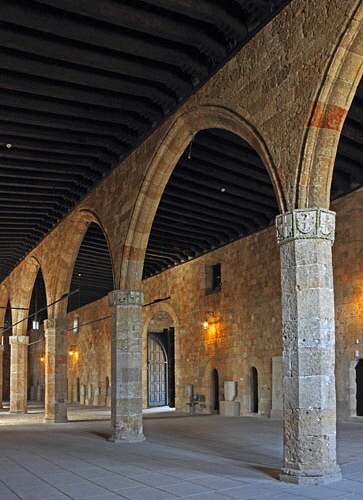
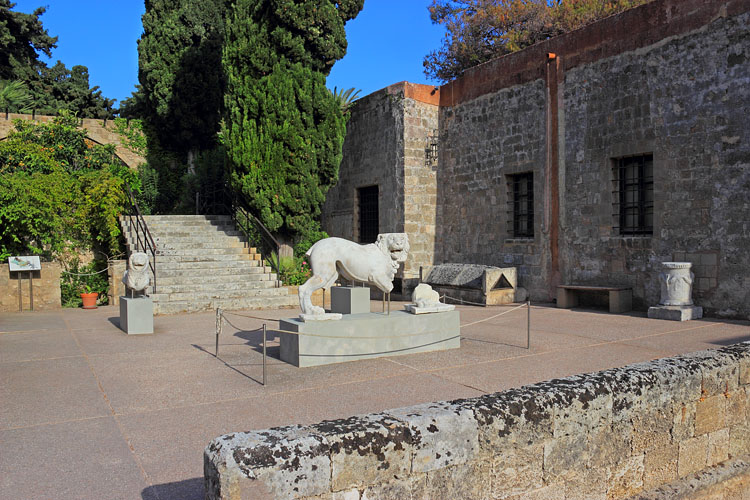
Linking the Archaeological Museum with the Palace of the Grand Master is the Street of the Knights, a beautifully preserved thoroughfare lined with medieval buildings and architecture.
Street of the Knights
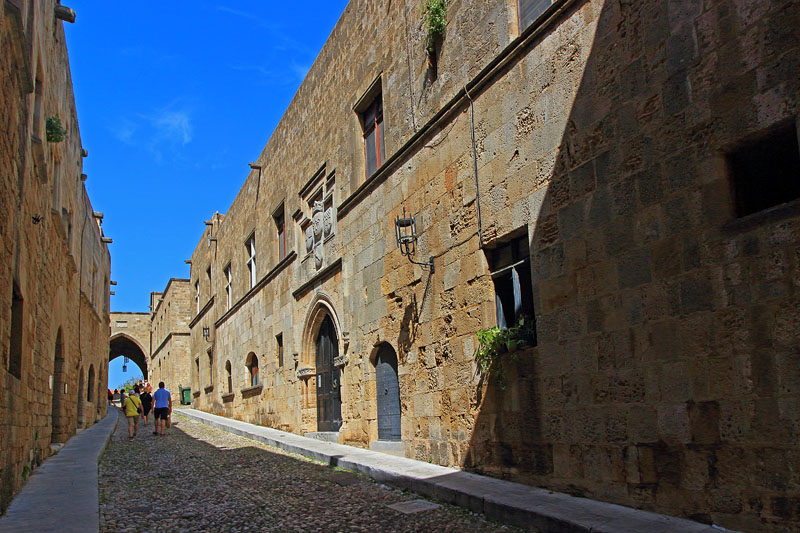
There are several open-air sites like the ruins of the Church of Panagia of the Burgh, the remains of the 3 BC Temple of Aphrodite as well as several other excavation sites spread around the Old Town. The town walls are around 4 km in length, and parts of it can be walked, such as along a dry moat.
Ruins of the Church of Panagia
Excavation sites
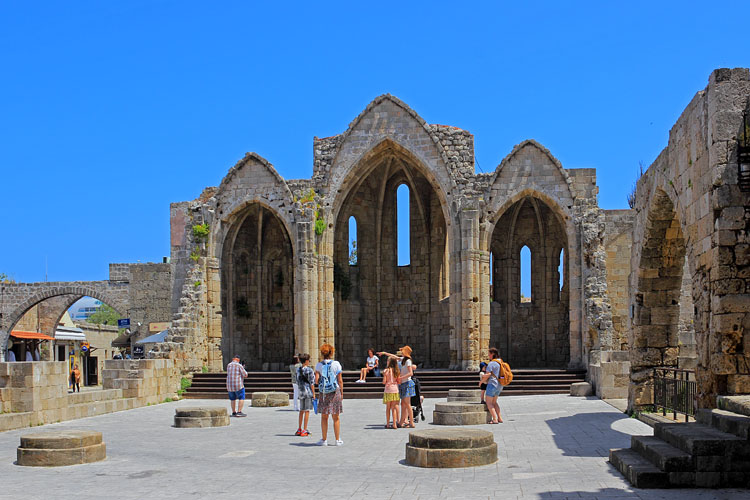
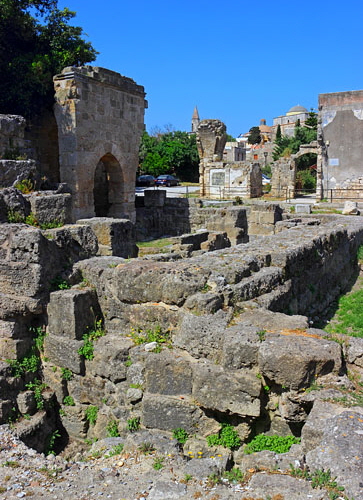
One of the charming things about the Old Town is also exploring the residential parts, with narrow stone-paved streets, alleys, and tiny houses. Other areas to see are the Jewish Quarter and the 16th century Suleyman Mosque bearing the legacy of the Ottoman period.
Suleyman Mosque
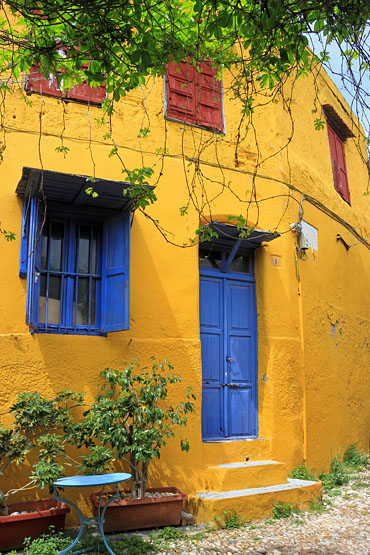
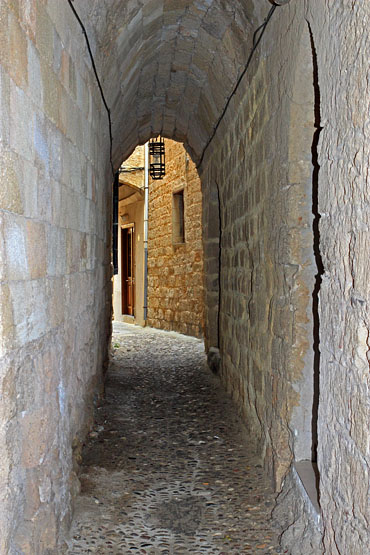
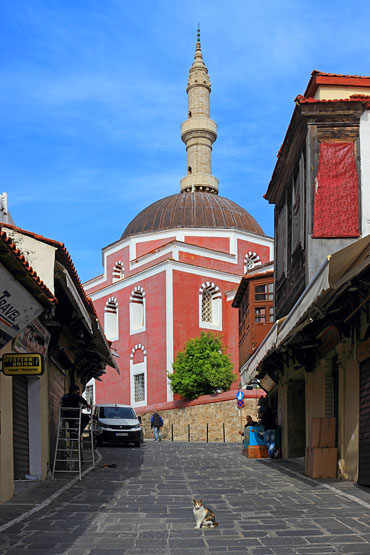
None of the ancient sites is too far to explore on foot. And a 30-minute walk via the residential streets of the new town is the 3 BC site and ruins of the Acropolis, the Stadium, and the Odeon. Unfortunately the day
I was there the Acropolis was covered in scaffolding for restoration work. The elongated granite hewn 'Olympic' stadium is a masterpiece of craftsmanship. Sitting on one of the rows of steps, one could immerse oneself in imagining sporting events and the cheering crowds. Today, it’s used by a few joggers, doing the circuit. Nearby is also the partially restored Odeon, which is said to have accommodated 800 spectators.
The complex is also a nice place for a picnic, as there are lots of shady areas, wild vegetation, and several other bits of ruins that can be seen.
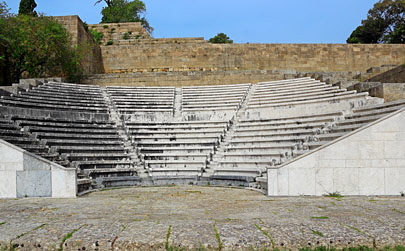
The Odeon
Remains of the Stadium
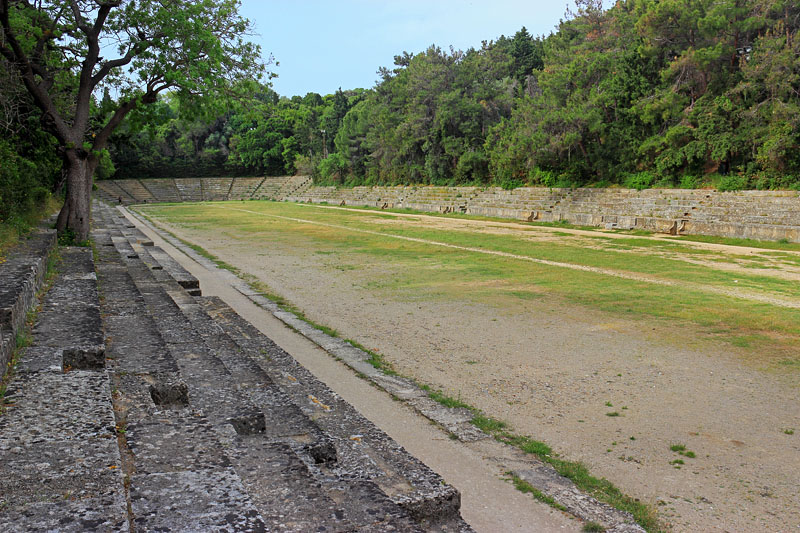
Mandraki is the town’s main harbour, which in ancient times was supposed to hold the statue of the mythical giant Colossus of Rhodes (Greek sun-god Helios). Today however, where once stood the feet of Colossus on either side of the harbour entrance, are two columns instead. On top of one is a bronze statue of a doe and on the other is a stag (deer being a heraldic symbol of Rhodes). On the north side is also the castle of St Nicholaos, which operates as a lighthouse. It is a popular photographic sight, as the evening sun goes down, lighting up the columns, lighthouse and harbourfront.
Mandraki harbour, and St Nicholaos Castle

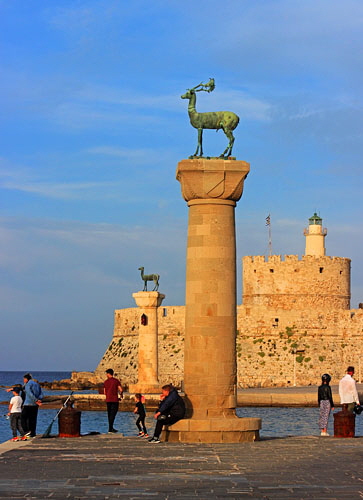
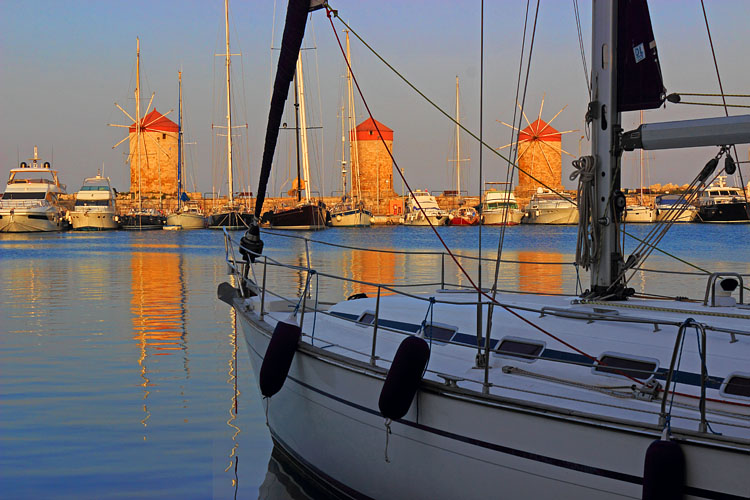
The harbourfront promenade with moored yachts and tour boats is also a great place for an evening stroll, and whet your appetite for dining at one of many nearby restaurants. To get a panoramic view of the town’s waterfront and Old Town walls, I took an evening stroll along the half kilometre long breakwater. Here, three restored medieval windmills stand, which have become a harbourfront landmark. It’s a perfect photo opportunity, with just about every tourist posing by them.
Boasting 300 sunny days a year, Rhodes caters to both seaside holidaymakers and the sightseeing aficionados. It certainly is one of the best Greek islands that combines beauty with the past.
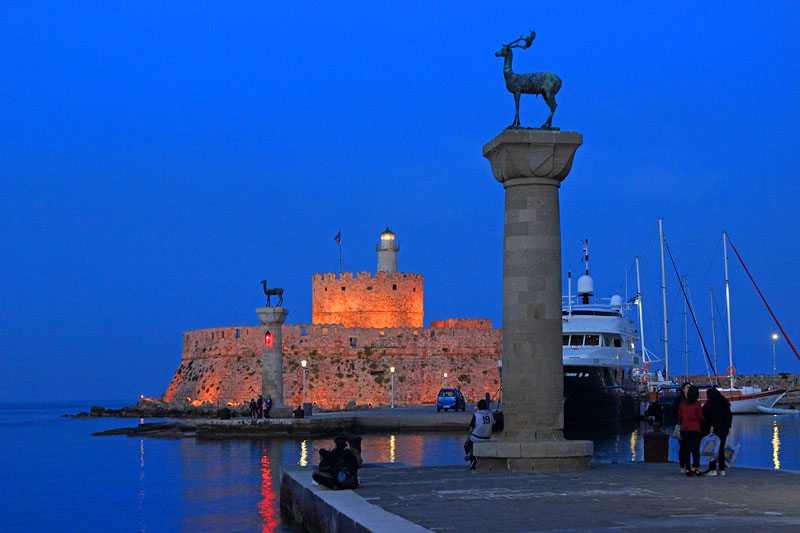
FACT FILE:
Getting there:
there are numerous tour operators with package holidays.
It is also easy to make your own itinerary by separately booking your flights and hotels, which I did.
Getting around:
Rhodes has more historic sites and pretty villages than the two I stayed at. And renting a car is the best way. Taxis are available in most places but can soon add up to the cost. From Rhodes Airport to Lindos is around 70 Euros. The local bus service is cheap but slow.
Eating out:
in both Lindos main tourist streets and Rhodes Old Town (especially around Hippocrates Square), restaurant prices tend to be higher than in the less patronised back street areas. Cuisine wise you can’t go wrong if you choose delicious Greek cheeses, salads, traditional Moussaka, and seafood like Squid and Octopus, which were my favourites.
Staying in Lindos:
there are several small hotels in the village, that you can book direct. Bear in mind, due to traffic restrictions, be prepared to walk from the main road, which can be steep.
Staying in Rhodes Town:
if you want a seaside resort, yet be close to the Old Town, the Ellis Beach (pebble, not sandy), has a few seafront hotels.
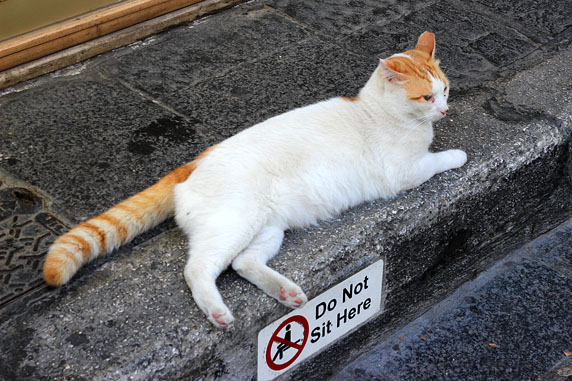
The cats of Rhodes: the island is famous for its cats. Whether stray or pets, you can’t miss them and is a part of the landscape. And especially in Lindos, you’ll see plenty lazing around shady spots. More about them can be read online.
25 images here ©JAYTRAVELPHOTOS
© COPYRIGHT notice. The images on this site are for viewing only.
To purchase any, for personal or commercial use, please contact us at jaytravelphotos@aol.com
___________________________________________________________________________________________________________________________________________
